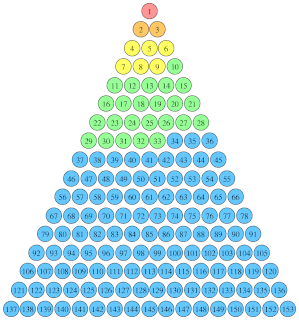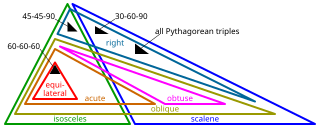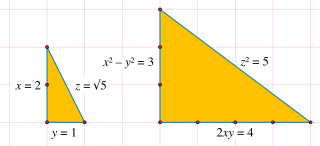
A Pythagorean triple consists of three positive integers a, b, and c, such that a2 + b2 = c2. Such a triple is commonly written (a, b, c), and a well-known example is (3, 4, 5). If (a, b, c) is a Pythagorean triple, then so is (ka, kb, kc) for any positive integer k. A primitive Pythagorean triple is one in which a, b and c are coprime. A triangle whose sides form a Pythagorean triple is called a Pythagorean triangle, and is necessarily a right triangle.
In mathematics, a Fermat number, named after Pierre de Fermat, who first studied them, is a positive integer of the form
In recreational mathematics, a repdigit or sometimes monodigit is a natural number composed of repeated instances of the same digit in a positional number system. The word is a portmanteau of repeated and digit. Examples are 11, 666, 4444, and 999999. All repdigits are palindromic numbers and are multiples of repunits. Other well-known repdigits include the repunit primes and in particular the Mersenne primes.

The square root of 2, or the one-half power of 2, written in mathematics as or , is the positive algebraic number that, when multiplied by itself, equals the number 2. Technically, it must be called the principal square root of 2, to distinguish it from the negative number with the same property.
In mathematics, a proof by infinite descent, also known as Fermat's method of descent, is a particular kind of proof by contradiction used to show that a statement cannot possibly hold for any number, by showing that if the statement were to hold for a number, then the same would be true for a smaller number, leading to an infinite descent and ultimately a contradiction. It is a method which relies on the well-ordering principle, and is often used to show that a given equation, such as a Diophantine equation, has no solutions.

In elementary number theory, a centered square number is a centered figurate number that gives the number of dots in a square with a dot in the center and all other dots surrounding the center dot in successive square layers. That is, each centered square number equals the number of dots within a given city block distance of the center dot on a regular square lattice. While centered square numbers, like figurate numbers in general, have few if any direct practical applications, they are sometimes studied in recreational mathematics for their elegant geometric and arithmetic properties.
In geometry, a Heronian triangle is a triangle that has side lengths and area that are all integers. Heronian triangles are named after Hero of Alexandria. The term is sometimes applied more widely to triangles whose sides and area are all rational numbers, since one can rescale the sides by a common multiple to obtain a triangle that is Heronian in the above sense.

In mathematics, the Pell numbers are an infinite sequence of integers, known since ancient times, that comprise the denominators of the closest rational approximations to the square root of 2. This sequence of approximations begins 1/1, 3/2, 7/5, 17/12, and 41/29, so the sequence of Pell numbers begins with 1, 2, 5, 12, and 29. The numerators of the same sequence of approximations are half the companion Pell numbers or Pell–Lucas numbers; these numbers form a second infinite sequence that begins with 2, 6, 14, 34, and 82.

A special right triangle is a right triangle with some regular feature that makes calculations on the triangle easier, or for which simple formulas exist. For example, a right triangle may have angles that form simple relationships, such as 45°–45°–90°. This is called an "angle-based" right triangle. A "side-based" right triangle is one in which the lengths of the sides form ratios of whole numbers, such as 3 : 4 : 5, or of other special numbers such as the golden ratio. Knowing the relationships of the angles or ratios of sides of these special right triangles allows one to quickly calculate various lengths in geometric problems without resorting to more advanced methods.

A Pythagorean prime is a prime number of the form 4n + 1. Pythagorean primes are exactly the odd prime numbers that are the sum of two squares; this characterization is Fermat's theorem on sums of two squares.

In number theory, a congruum is the difference between successive square numbers in an arithmetic progression of three squares. That is, if x2, y2, and z2 are three square numbers that are equally spaced apart from each other, then the spacing between them, z2 − y2 = y2 − x2, is called a congruum.
In mathematics, the Ulam numbers comprise an integer sequence devised by and named after Stanislaw Ulam, who introduced it in 1964. The standard Ulam sequence starts with U1 = 1 and U2 = 2. Then for n > 2, Un is defined to be the smallest integer that is the sum of two distinct earlier terms in exactly one way and larger than all earlier terms.
In mathematics and statistics, sums of powers occur in a number of contexts:

In geometry, the spiral of Theodorus is a spiral composed of right triangles, placed edge-to-edge. It was named after Theodorus of Cyrene.

In mathematics, the Pythagorean theorem, or Pythagoras's theorem, is a fundamental relation in Euclidean geometry among the three sides of a right triangle. It states that the area of the square whose side is the hypotenuse is equal to the sum of the areas of the squares on the other two sides. This theorem can be written as an equation relating the lengths of the sides a, b and c, often called the Pythagorean equation:

An integer triangle or integral triangle is a triangle all of whose sides have lengths that are integers. A rational triangle can be defined as one having all sides with rational length; any such rational triangle can be integrally rescaled to obtain an integer triangle, so there is no substantive difference between integer triangles and rational triangles in this sense. However, other definitions of the term "rational triangle" also exist: In 1914 Carmichael used the term in the sense that we today use the term Heronian triangle; Somos uses it to refer to triangles whose ratios of sides are rational; Conway and Guy define a rational triangle as one with rational sides and rational angles measured in degrees—in which case the only rational triangle is the rational-sided equilateral triangle.

Fermat's right triangle theorem is a non-existence proof in number theory, the only complete proof given by Pierre de Fermat. It has several equivalent formulations:
In mathematics, statistics and elsewhere, sums of squares occur in a number of contexts:

In plane geometry, an automedian triangle is a triangle in which the lengths of the three medians proportional to the lengths of the three sides, in a different order. The three medians of an automedian triangle may be translated to form the sides of a second triangle that is similar to the first one.
Pythagorean Triangles is a book on right triangles, the Pythagorean theorem, and Pythagorean triples. It was originally written in the Polish language by Wacław Sierpiński, and published in Warsaw in 1954. Indian mathematician Ambikeshwar Sharma translated it into English, with some added material from Sierpiński, and published it in the Scripta Mathematica Studies series of Yeshiva University in 1962. Dover Books republished the translation in a paperback edition in 2003. There is also a Russian translation of the 1954 edition.















